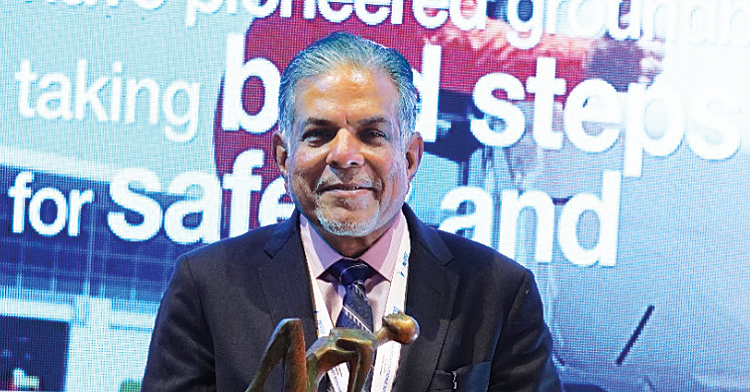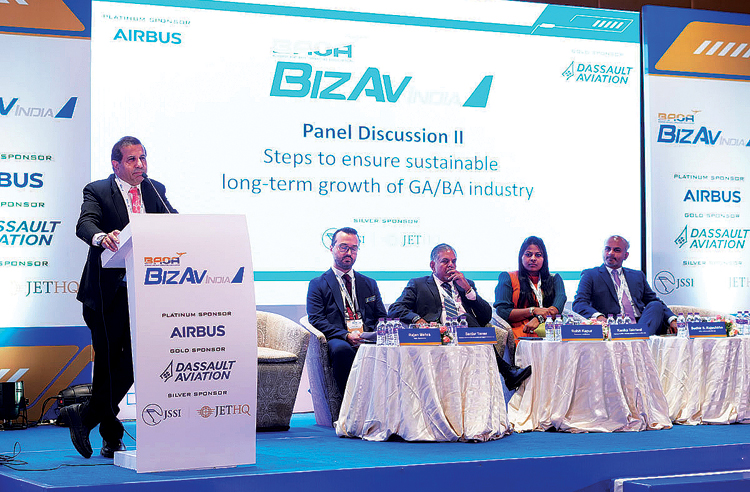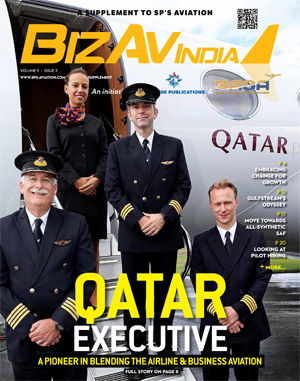GA/BA as Aviation’s Growth Accelerator
Held on the sidelines of WINGS India 2022 in Hyderabad, the BizAvIndia conference brought together the industry stakeholders after a transitioned post-pandemic world and streamlined the way forward

After two years of virtual interactions over Zoom calls, Google Meet, Microsoft Teams, etc; the business aviation fraternity of India reconvened in Hyderabad for the 6th edition of the BizAvIndia Conference held on March 23, 2022. Organised by the Business Aircraft Operators Association (BAOA), the conference’s theme was GA/BA - The Growth Enabler. The conference also marked the start of the 2022 edition of WINGS India conference.
This year, the BizAvIndia conference aimed to capture Social and Economic Impact of Business and General Aviation in India as the overarching theme, to encourage discourse on meaningful contribution of BA/GA on nation’s economy, at a time when the Indian Government appears to be drawing a long-term vision for development of aviation, the association laid out. The theme also scopes out discussions on infrastructure requirements in order for BA/GA sector to grow its potential in the coming times.
“The Business Aviation industry has undergone a sea change over the past decade in India and has gained much recognition in the recent years. The utility of Business Aviation, as a productivity tool and a contributor to economic development, is becoming more evident and should serve as the prime rationale to put in place an appropriate framework enabling industry’s growth and its role in channelising economic and social benefits throughout India,” BAOA stated.
Stalwarts from the GA/BA discussed the role of the industry, the pain points it currently faces as well as the cooperative steps that the industry and the government needs to take going ahead. The industry also discussed that while there are still challenges especially pertaining to the perception that people have about the BizAv industry, the pandemic has proven to be a positive force in changing that. The impact that the coronavirus had on travel also shifted people’s travelling habits. As hygiene and avoiding the crowd took priority people started looking at private aviation more than just luxury.

“What BAOA gave to this country was a unified voice for the industry. This is a nation building industry and its time people start understanding that. It is a perception battle. However, the industry does add to the economy, the GDP of the nation. It generates employments, allows business leaders to move freely, hence grow their businesses and all of that adds in nation building. As BAOA, we have been and still are a very formidable voice. As part of the industry, all of the stakeholders have to keep personal issues aside and pick on the interest that are for the common good of the industry,” said Rohit Kapur, President – Asia, JetHQ and Former President, BAOA. As a major highlight moment from the event, Kapur was conferred with the outstanding achievement award during the conference as the association’s expression of gratitude for what he has done for the industry in India. The award was presented to him by Ted Farid, Chairman, JetHQ.
Group Captain Rajesh K. Bali (Retd), Managing Director, BAOA also highlighted the misconception that persists about the role of this industry in the nation’s GDP. “However, the realisation is setting in that this industry is as important for the country as scheduled airlines. He highlighted that issues like affordability and infrastructural concerns as identified in the National Civil Aviation Policy regarding the GA/BA industry are also being catered to.
As part of the deliberations, the conference held two major panel discussions. The panelists discussed about enabling the Small Aircraft Subschema (SAS) through coordinated mechanism; the financial aspects of SAS, the lessons learnt from UDAN (Ude Desh Ka Aam Nagrik)/Regional Connectivity Scheme (RCS) & way forward, use of Business Jets for regional connectivity & tourism, etc.
“WHAT BAOA GAVE TO THIS COUNTRY WAS A UNIFIED VOICE FOR THE INDUSTRY. THIS IS A NATION BUILDING INDUSTRY AND ITS TIME PEOPLE START UNDERSTANDING THAT. AS BAOA, WE HAVE BEEN AND STILL ARE A VERY FORMIDABLE VOICE,” SAID ROHIT KAPUR, PRESIDENT – ASIA, JETHQ AND FORMER PRESIDENT, BAOA
There was also focus on the necessary steps to ensure sustainable long-term growth of GA/BA industry that included the MRO support and the measures required for sustained MRO growth in GA/BA industry, regulatory issues needing rationalisation to achieve optimal growth of BA industry, regulatory challenges on small aircraft operations.
While discussing about regulatory issues and regulatory bodies like the Directorate General of Civil Aviation (DGCA), an important change highlighted was the enabling of eGCA which has been implemented in many stages. Launched by DGCA, eGCA is an online a portal that provides end-to-end digital solutions for all the aviation stakeholders, including pilots, aircraft engineers, operators and flying training organisations.
In one of the panel discussions there were also talks about the use of helicopters in remote/hilly areas. Group Captain Bali underlined helicopters as a significant aspect of the GA/BA industry. He also put light on the alarming reduction in inventory of helicopters in India where in from about 370 helicopter the number has come down to a mere 160 around today and the issue is being repeatedly discussed. Sunny Guglani, Head of Airbus Helicopters, India & South Asia also stated that Helicopter is the key thread of the fabric of aviation in India. “We have to find opportunities in the UDAN (RCS) scheme to boost GA/BA in the country. We can utilise this scheme for helicopters as well. Helicopters can be inducted in areas like Himachal Pradesh, Uttarakhand and be implemented under this scheme. Assets like helicopter in our varied geography can be made beneficial with schemes like UDAN and SAS.”
Guglani also added that regulations which liberate not constraint are needed and taxation needs to be rationalised. “It takes about three months for security clearance and six months for DGCA clearances. Why can this not be brought down to say about months. A conscious effort to bring it down to some extent can be made.”

While expanding on the leasing of small aircraft through GIFT City, Kanika Tekriwal, Co-Founder & CEO, JetSetGo Aviation Services Pvt Ltd, shared her experiences of leasing multiple aircraft throughout the pandemic, the hassles her company faced and the challenges that they encountered when no one wanted to directly do business with India. She pointed out, “During every import we thought this is not going to happen.” However, she said that when it comes to GIFT city, she realised that it is a rather effective system to bring planes into the country especially considering that it gives the leasing company the freedom to take back the aircraft when they want. “GIFT city has enabled an ecosystem wherein a leasing company is given that support. The government being so active, everyone made sure that what we wanted happened. Even though it took some time and we lost money, yet we are continuing to lease and are leasing four more planes through GIFT city. I would encourage you all to explore this method because that’s the only way when you can actually get assets into the country without spending millions and facing the issues everyone heckles with,” she stated during her address as part of a panel.
Fractional Ownership of aircraft was one of the extensively discussed subject alongside the financial aspects of this model in India. Sudhir Rajeshirke, Chief Operating Officer, JetClub reiterated that business aviation in India has the opportunity to accelerate the next stage of aviation growth in the nation & aircraft fractional ownership model will help leverage that growth. “Through the fractional ownership model, owners are able to take depreciation on their own share of the assets. This is huge tax advantage to all potential aircraft buyers. The model solves many pain points & can change the landscape for fixed wing as well as helicopters,” he added.
Guglani also underlined that one of the wrinkles to be ironed out is fractional ownership. It has the potential to revolutionise this industry like no other policy can. It can bring out immense transformation in the business. “Fractional ownership will democratise the access to GA/BA and lower that perception part by making it more accessible,” he added.
Amid the concerns and challenges, the conference ensured to put out that while there is a lot to be done, it cannot be sidelined that a lot has happened also especially in the recent past. And to continue achieving the needs, well researched papers must be put forth to present the views and not just rhetoric, Stated Group Captain Bali.
Rajeshirke also mentioned the following points to be kept in mind as the industry upscales its efforts to grow in the nation.
- Structure your argument very well in a way that it shows minimum number of changes required to implement a model in India. Structure the ask, provide data, add relevant information, with risks and rewards included.
- Remember the need to educate. Whether it is the ministers, or the regulators, clearly showcase as to how it actually works at the ground level; simplify things with practical reality.
- Layout a clear action plan. For example, DGCA formed a working committee to present a paper on fractional ownership model. Within one month the paper was ready; within the next two months in the first week of February, a presentation was given to the Civil Aviation Minister. He gave a go ahead to roll out this model on a timebound manner and as a result, there is an engagement plan.





